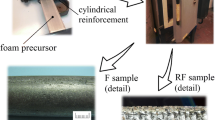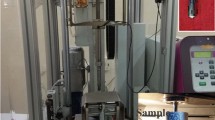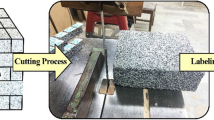Abstract
The objective in here is to compare the design of a corrugated wire mesh laminate (CWML) with an open-cell mockup by using a uniaxial shear test. This paper depicts the fabrication of CWML specimens by using a transient liquid phase (TLP) skill at low temperatures and a design of a shear testing frame, and then applying uniaxial shear loading. The material used in the fabrication is a 316 stainless steel woven wire mesh with a 0.22-mm wire diameter and 0.95-mm aperture. Tin-alloy (95%Sn–5%Ag) is used as the bonding material in the TLP method, and the designed shear frames are glued with epoxy. The fabricated samples are tested under a uniaxial condition to determine their shear behaviors. Finite element software is employed to model the CWML and study its reaction to mechanical shear loading. The results of the numerical simulation are confirmed by experimental results for the shear loading behavior. Finally, the CWML is concluded to be of an open-cell foam type, and the results of the numerical model show a reasonably linear match to the experimental results on a log-log scale.
Similar content being viewed by others
Abbreviations
- CWML:
-
corrugated wire mesh laminates
- C :
-
constant
- dL :
-
displacement (mm)
- EXP:
-
experiment
- E :
-
Young’s modulus of the foam itself (MPa)
- E eff :
-
Effective modulus of wire cloth (MPa)
- E s :
-
Young’s modulus of its base material (MPa)
- E T :
-
tangent modulus (MPa)
- FEA:
-
finite element analysis
- FE4L:
-
finite element model of CWML 4 layers
- G T :
-
through-thickness shear modulus
- L :
-
average length of the specimen (mm)
- L/T :
-
aspect ratio (or length-to-thickness) of CWML geometry
- MTS:
-
mechanical testing machine
- n :
-
power number acquired using log-log scale
- P :
-
applied force (N)
- ROT:
-
rotation
- R :
-
radius (mm)
- STD:
-
standard deviation
- T :
-
thickness of the specimen (mm)
- TLP:
-
transit liquid phase
- t :
-
thickness of unit model of corrugated wire mesh laminate (mm)
- W :
-
average width of the specimen (mm)
- X:
-
horizontal direction
- σ 0.25 :
-
normal plastic collapse occurs at 25% strain (MPa)
- σ pl :
-
normal plastic stress
- σ ULT :
-
ultimate strength (MPa)
- σ YS :
-
yield strength (MPa)
- ɛ ULT :
-
ultimate strain
- ρ :
-
density of the foam itself (kg/m3)
- ρ s :
-
density of base material (kg/m3)
References
Sypeck, D. J., “Constructed cellular metals,” Proc. of TMS Conference on Processing and Properties of Lightweight Cellular Metals and Structures, pp. 35–45, 2002.
Chisholm, J., “Method of making a crimped wire mesh heat exchanger/sink,” US Patent, No. 4843693, 1989.
Queheillalt, D. T., Hass, D. D., Sypeck, D. J., and Wadley, H. N., “Synthesis of open-cell metal foams by templated directed vapor deposition,” Journal of Materials Research, Vol. 16, No. 4, pp. 1028–1036, 2001.
Sypeck, D. J. and Wadley, H. N. G., “Multifunctional microtruss laminates: Textile synthesis and properties,” Journal of Materials Research, Vol. 16, No. 3, pp. 890–897, 2001.
Jeon, S. H., Choi, W. C., Park, T. H., Kim, H. M., Jung, I. E., Baek, C. K., Seo, K. J., and Choi, B. H., “Development of a new lightweight car audio using polycarbonate/acrylonitrile-butadiene-styrene copolymer composite based hybrid material,” Int. J. Precis. Eng. Manuf., Vol. 13, No. 1, pp. 85–96, 2012.
Kim, S. C., Kim, J. S., and Yoon, H. J., “Experimental and numerical investigations of mode I delamination behaviors of woven fabric composites with carbon, Kevlar and their hybrid fibers,” Int. J. Precis. Eng. Manuf., Vol. 12, No. 2, pp. 321–329, 2011.
Choi, J., “Fabrication and compressive yield strength of open cell corrugated cellular solid, M.Sc. thesis, Aerospace engineering department,” Embry-Riddle Aeronautical University, 2005.
Choi, J., Shankar, K., Neely, A. J., and Fien, A., “Methods for manufacture of corrugated wire mesh laminates,” Proc. of International Journal of Aerospace and Mechanical Engineering, pp. 1181–1187, 2009.
Caulfield, J., Karlsson, A. M., and Sypeck, D. J., “Crushing of a textile core sandwich panel,” AIAA Journal, Vol. 44, No. 6, pp. 1339–1344, 2006.
Wadley, H. N. G., “Multifunctional periodic cellular metals,” Philosophical transactions of the royal society of London series A-Mathematical physical and engineering sciences, Vol. 364, No. 1838, pp. 31–68, 2006.
Chisholm, J., “Attaching crimped wire mesh to an object requiring heat,” US Patent, No. 5312508, 1994.
Sypeck, D. J., “Wrought aluminum truss core sandwich structures,” Metallurgical and Materials Transactions B-process Metallurgy and Materials Processing Science, Vol. 36, No. 1, pp. 125–131, 2005.
Sypeck, D. J., “Cellular truss core sandwich structures,” Applied Composite Materials, Vol. 12, No. 3–4, pp. 229–246, 2005.
Sypeck, D. J. and Wadley, H. N. G., “Multifunctional periodic cellular solids and the method of making same,” US Patent, No. 0154252, 2004.
Morye, S. S., Hine, P. J., Duckett, R. A., Carr, D. J., and Ward, I. M., “Modelling of the energy absorption by polymer composites upon ballistic impact,” Composites Science and Technology, Vol. 60, No. 14, pp. 2631–2642, 2000.
Li, Q. M., Mines, R. A. W., and Birch, R. S., “The crush behaviour of rohacell-51WF structural foam,” International Journal of Solids and Structures, Vol. 37, No. 43, pp. 6321–6341, 2000.
Kelsey, S., Gellatly, R. A., and Clark, B. W., “The shear modulus of foil honeycomb cores: A theoretical and experimental investigation on cores used in sandwich construction,” Aircraft Engineering and Aerospace Technology, Vol. 30, No. 10, pp. 294–302, 1958.
Lewis, E. L. V., Richardson, I. D., and Ward, I. M., “A hall-effect apparatus for the measurement of simple shear in polymers,” Journal of Physics E: Scientific Instruments, Vol. 12, No. 3, pp. 189, 1979.
Mespoulet, S., Hodgkinson, J. M., Matthews, F. L., Hitchings, D., and Robinson, P., “Design, development, and implementation of test methods for determination of through thickness properties of laminated composites,” Plastics, Rubber and Composites, Vol. 29, No. 9, pp. 496–502, 2000.
Grédiac, M. and Dufort, L., “Experimental evidence of parasitic effects in the shear test on sandwich beams,” Experimental Mechanics, Vol. 42, No. 2, pp. 186–191, 2002.
Côté, F., Deshpande, V. S., and Fleck, N. A., “Shear fatigue strength of a prismatic diamond sandwich core,” Scripta Materialia, Vol. 56, No. 7, pp. 585–588, 2007.
ASTM D4255/D4255M-01, “Standard test method for in-plane shear properties of polymer matrix composite materials by the rail shear method,” 2007.
ASTM C273/C273M-07a, “Standard test method for shear properties of sandwich core materials,” 2007.
Gibson, L. J. and Ashby, M. F., “Cellular solids: Structure and properties, 2nd edition,” Cambridge University Press, 1999.
Author information
Authors and Affiliations
Corresponding author
Rights and permissions
About this article
Cite this article
Choi, J., Shankar, K., Choi, B. et al. In-plane shear behavior of corrugated cellular solids and validation of an open-cell corrugated cellular solid. Int. J. Precis. Eng. Manuf. 14, 1767–1774 (2013). https://doi.org/10.1007/s12541-013-0236-2
Received:
Accepted:
Published:
Issue Date:
DOI: https://doi.org/10.1007/s12541-013-0236-2




